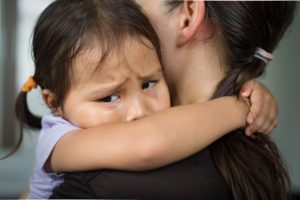Your Child’s Anxiety: Signs and Strategies for Calming Their Mind and Body

Did you know that anxiety disorders are the most common type of psychological problem that children experience? One in eight children suffer from a significant anxiety disorder (Wang, 2017). In an average sized classroom of about 25 school-aged children, 3 students suffer from anxiety (Anderson, 2016). Additionally, anxiety is on the rise – between 2016 and 2020, the number of children aged 3-17 diagnosed with an anxiety disorder grew by 29 percent (Assistant Secretary for Public Affairs (ASPA), 2022).
Here are some signs to look out for to know if your child is dealing with anxiety:
- Physical distress (shaking, crying, hyperventilating, screaming)
Fleeting, escaping - Refusal to engage in activities that cause distress
- Outright statements and questions expressing fears (“What if you get in a car accident when you go out?”)
- Refusal to be alone
- Extreme distress upon contact with feared object (dogs, birds, planes, extreme weather, etc.)
The signs mentioned above are some of the most obvious signs of anxiety. There are some less obvious signs we should be aware of as well:
- Clingy behavior
- Argumentative behavior
- Reassurance-seeking behavior
- Sleep difficulties (refusal to sleep alone, go on sleepovers, etc.)
- Extreme shyness or sensitivity
- Physical aggression
- Reluctance to try new things (activities, foods, places, routines, etc.)
If your child is experiencing anxiety, there are things you can do at home to help them. You will want to help them calm their body and calm their mind. When children feel anxious, they may experience dizziness, a racing heart, sweaty palms, a stomach ache, or other physical symptoms. During times when they are experiencing these somatic symptoms of anxiety, it is important to remind your child that these are just normal feelings of anxiety and they will pass. Here are some strategies to help with calming the body:
- Try Deep Breathing – Some of the bodily feelings of anxiety such as dizziness and others are caused by changes in our breathing when anxious. Our breathing tends to be faster and shallower when we feel anxious, so taking slow and deep breaths can help to counter those feelings.
- Activate the Vagus Nerve – The vagus nerve is a long nerve that starts in your brain stem, at the base of your skull. It stretches from your skull through your neck and into your chest cavity and abdomen. The nerve is like a brake system that restores you back to a steady state by secreting acetylcholine. It is what makes yoga and breathing exercises effective. You can activate this nerve by humming. When you hum, your vocal cords vibrate and stimulate this nerve. Splashing cold water on your face also helps activate this nerve.
- Practice Progressive Muscle Relaxation – When we are anxious, our muscles have a tendency to tense up. Progressive Muscle Relaxation (PMR) can be practiced by tensing and relaxing the muscle groups in the body. For example, if the arm muscles are feeling tense, your child can make a tight fist, and hold it for about a minute, and then release the fist. There are follow along videos online to guide you and your child through a progressive muscle relaxation exercise. Here is a helpful video to help you practice PMR with your child.
- Avoid Caffeine – Making this dietary change, especially when your child is about to experience a potentially anxiety-provoking situation, can help prevent bodily reactions to anxiety or make them less bothersome. Instead of drinking coffee or caffeinated sodas, try calming teas such as chamomile or lavender.
Once you calm the body, here are some helpful strategies to help calm the mind:
- Change Anxious Thoughts – A lot of anxious thoughts start off with “What if…” What if I fail? What if everything goes wrong? Helping your child to change these “what if” thoughts to more helpful thoughts can reduce anxiety. So instead of thinking, “What if I fail?” your child can change the thought to “I can try my best and that is good enough.”
- Schedule Worry Time – When worrying, there is a tendency to think about the anxious situation repeatedly. Putting a limit on time spent worrying can reduce this. For example, you can give your child 15 minutes, but then they have to put their attention on something else once the time is up.
- Give Your Child a Role – An example of this would be if your child was going to a birthday party, give them something to do – like hand out drinks at the party. This strategy is especially helpful with social anxiety. When children have a role, they know where they fit into a situation. It can help them get more excited about the social event instead of thinking about all the ways the event could go wrong.
Using strategies for calming the body and mind can have a major impact on reducing your child’s anxiety. You may be wondering if your child’s anxiety is significant enough to warrant mental health intervention. If your child is experiencing symptoms mentioned above and they interfere with daily life, your child may benefit from mental health counseling by either a mental health therapist, social worker, or psychologist. Some children benefit from medication and will need to be evaluated for medication by a psychiatrist.
References
Edwards, A. (2013). Why Smart Kids Worry: And What Parents Can Do To Help. Sourcebooks, Inc.
Marks, T. (2022). Why Am I So Anxious? Powerful Tools for Recognizing Anxiety and Restoring Your Peace. Dorling Kindersley Limited.
Anderson, M. (2016, August 31). Mental Health In Schools: A Hidden Crisis Affecting Millions Of Students. NPR. https://www.npr.org/sections/ed/2016/08/31/464727159/mental-health-in-schools-a-hidden-crisis-affecting-millions-of-students.
Assistant Secretary for Public Affairs (ASPA). (2022, March 14). New HHS Study in JAMA Pediatrics Shows Significant Increases in Children Diagnosed with Mental Health Conditions from 2016 to 2020. HHS.gov. https://www.hhs.gov/about/news/2022/03/14/new-hhs-study-jama-pediatrics-shows-significant-increases-children-diagnosed-mental-health-conditions-2016-2020.html#:~:text=The%20study%2C%20conducted%20by%20the,with%20depression%20by%2027%20percent.
Wang, Z. (2017, August 1). Introduction. Anxiety in Children – NCBI Bookshelf. https://www.ncbi.nlm.nih.gov/books/NBK476265/#:~:text=Childhood%20anxiety%20disorders%20are%20very%20common%2C%20affecting%20one%20in%20eight%20children.&text=The%20National%20Institute%20of%20Mental,percent%20for%20severe%20anxiety%20disorder.
